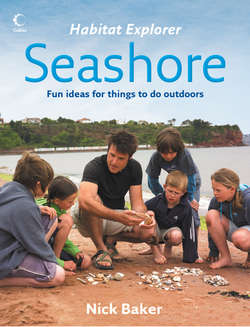Читать книгу Seashore - Nick Baker - Страница 13
Marvellous molluscs
ОглавлениеThese simple little cone-shaped shells are a familiar sight on a wave-beaten rocky shore. Their shell design and body shape are perfect for resisting the constant battering of the ocean. These molluscs have a large circular foot, which allows them to clamp tight to the rocks on which they live, making them very hard to prise off the rocks without doing any damage.
A combination of their habitual behaviour and the abrasive action of their shells on the rock means that they will often wear away the rock’s surface, leaving small circular pits as evidence of their home base. You can also sometimes see grazing trails similar to those left by their land-based relatives, the garden snails.
You might think that watching limpets is about as much fun as watching your parents tan! But you can turn even the dullest beach into a study zone. What do you know about these little molluscs? Not a lot, OK. So follow the steps opposite and you will learn a little bit more. This technique is used by biologists to study the movement of all kinds of animals.
Nick’s tricks
* You can take limpets by surprise! If you catch one with its shell slightly raised and you are quick, with one deft movement of your hand you can flick them off, giving you a chance to see the animal itself. Remember to put them back exactly where you found them.
* To see a limpet even more clearly, pop one inside a clear-sided observation tank and you will get a rock’s point of view of these often taken-for-granted tough little rock pool characters.
YOU WILL NEED
> quick-drying, non-water-based model paint in any bright colour
> paintbrush
> paper
> pencil
1 Using the model paint and paintbrush, mark a few limpets on a rock with a tiny blob of coloured paint.
2 Draw a map of the rocks and the positions of your colour-coded limpets.
3 Return the next day. Have they moved? Most of them probably won’t have, but some may well have moved a surprising distance. To find out just how much they do shuffle about, return to the same spot at night on a low tide. Try to find your molluscs then – you’ll be surprised . . .
Take it further
* Don’t feel you should limit your marking studies to limpets. You can try similar studies with any hard-shelled creatures, such as winkles and crabs.
* Use different-coloured paints for limpets on different rocks. With time, will they intermingle?
